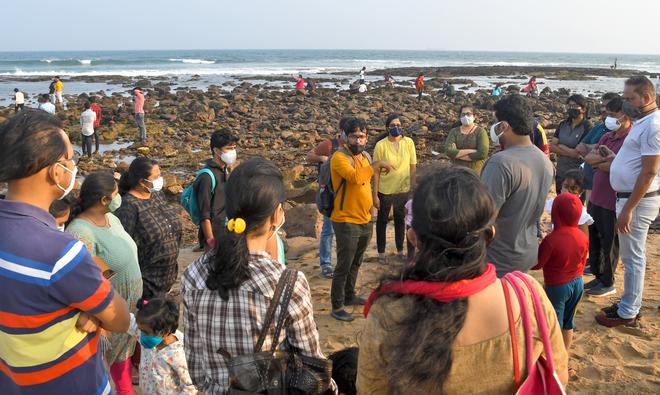One balmy morning, when marine biologist Sri Chakra Pranav Tamarapalli and his teammates Vimal Raj, Manish Manick and Pavan Sai Varma were walking along the Rushikonda during their usual research trips, they stumbled upon a brilliant blue creature making its way through the rocky tidal pools. Fascinated by the colour and shape, they were quick to click pictures and videos. “Initially, we thought it could be a nudibranch sea slug; but upon close observation we realised it was very thin and had branched guts like a polyclad,” says Pranav.
The vibrant coloured benthic organism was a species of polyclad flatworm Pseudoceros galatheensis, recorded for the first in Andhra Pradesh and East Coast mainland India.
Marine flatworms, also called polyclads, are usually seen in nearshore areas in tropical and sub-tropical areas. They are predatory and mainly feed on marine organisms like sponges, ascidians, crabs and other smaller organisms. Their role is vital as predators in coral reefs and other shallow water marine ecosystems. Their brilliant colour warns other predators that they are toxic and should not be consumed. “Though there are many recorded species of polyclad flatworms around the world, very less is known about them in the east coast of India, where the records were not described until recently. This makes this discovery significant and underlines the need for research in marine biology along the east coast, which has several such surprises that need to be documented,” says Pranav, founder and project manager, East Coast Conservation Team (ECCT), who along with Greenpaw, established the first record of the marine flatworms from the region.

This species was first identified in the Andamans in 2017 by Sudhanshu Dixit from the Zoological Survey of India. “This is not just the first range extension of the species but also the first record of the entire order of polycladida in the east coast,” adds Pranav.
The organism is about three centimetres in length with a light blue body and dark blue margins. A yellow median line beautifully passes through the middle. These organisms are usually seen in rocky as well as intertidal areas. They have two folds on the anterior side called pseudo tentacles with around 12 eyes spots on each fold that are used for sensing light. As thin as paper, they can surprisingly prey upon organisms like crabs by hunting them!
Visakhapatnam coast and the coast of Andhra Pradesh has a lot of potential in marine research, as very less data is available at present about marine ecosystems. ECCT and Greenpaw have started a project called Intertidal Biodiversity of Andhra Pradesh in which they involve everyday people to be citizen scientists in data collection for conservation. Any one with interest can join their Beginner Marine Explorer walks they conduct in collaboration with another city-based firm Wilded. “We have recorded more than 130 intertidal species through the project and expect to collect more data with help of citizen scientists who can join us,” says Pranav.
Andhra Pradesh has the second largest shoreline in India and has a lot of potential for marine research and conservation. “We have varied shores ranging from sandy, muddy and rocky shores that host different types of organisms. We also have varied ecosystems under water that are yet to be discovered. Marine megafauna such as sharks, rays, marlins, dolphins, whales and porpoises are abundant in our waters and waiting to be studied,” he adds.







